Finding antlers can be an enjoyable spring pastime for the curious naturalist, but can antler obsession be taken to such an extreme that it threatens wildlife?
In today’s blog, I’ll take a look at the extreme and sometimes downright-weird subculture that has grown around collecting shed antlers – and how that can quickly blossom into a major threat for already-stressed wildlife.
Tomorrow, I’ll share some tips for finding shed antlers responsibly.
Antlers & Me
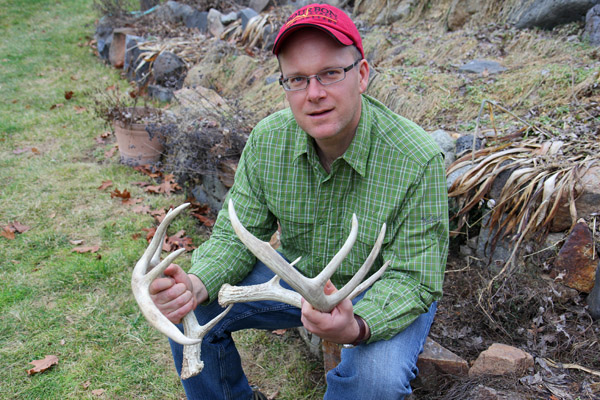
Full disclosure up front: I’m a full-blown antler enthusiast.
No, I’m not the guy who wears the t-shirt with a trophy buck emblazoned on it. But I consider the antlers I’ve found among my most treasured possessions.
As a life-long deer hunter and deer watcher, I always considered the appeal of antlers self-evident. Who doesn’t love antlers?
Then today I received a reality check in the form of my boss, Bob Lalasz. “Why would anyone collect antlers? I don’t get it. It’s not something I would do,” he said.
How to explain?
It’s no exaggeration to say I grew up in a culture of deer. The first two days of hunting season were official holidays for my central Pennsylvania school district. I read books about deer, wrote stories about deer, watched them, tracked them, learned everything I could about them.
As a naturalist, I also consider antlers one of the most interesting extravagances of the natural world.
They’re only found on members of the deer family – white-tailed and mule deer, elk, moose and caribou in North America. Unlike horns, antlers are true bone structure.
Also unlike horns, antlers are shed every year in late winter and early spring (in North America.
And when bucks discard their antlers, some of us go searching for them.
Antler Obsession
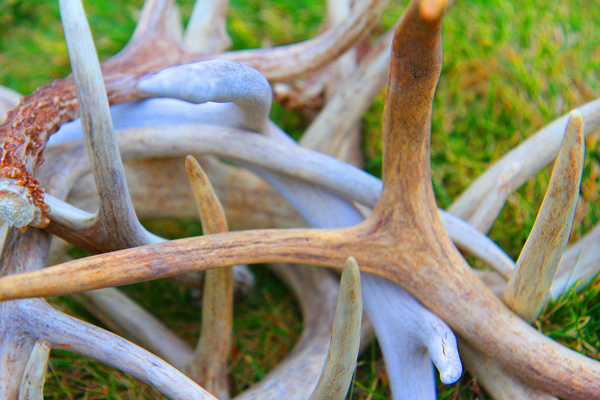
Despite my interest, I’ve admittedly always been a bit unfocused when searching for antlers – “sheds,” as enthusiasts call them.
Sure, I know there are spots where you can often turn up an antler or two. Mostly, I just keep an eye out for them when I’m hiking in the spring, the way I keep an eye out for birds.
But now, like so many activities, some have taken this pursuit to the level of obsession.
It’s no longer enough just to find an antler here and there. There are how-to books, blogs, Facebook pages and record books devoted to the activity.
Yes, record books.
There are “shed hunters” who use a measuring tape to record the size of the antlers in a complex process that results in a final “score.”
The scores of these antlers are compared in a record book kept by the North American Shed Hunter’s Club.
On the organization’s forum, members post trip reports as well as tricks for collecting sheds – like how to design a “trap” that collects the deer’s antlers by snagging them when they’re loose.
Some shed hunters search for antlers for the market, selling them for use as furniture, dog chew toys and other purposes.
Perhaps most bizarrely, you can now also purchase shed-sniffing dogs – often costing thousands of dollars – that will locate the antlers for you.
There’s a whole industry built around supplying products for “shed dogs” – how-to books and videos, “training antlers” and a wax scent that smells like antlers.
Of course, with so much time and money invested, things can get a bit…competitive.
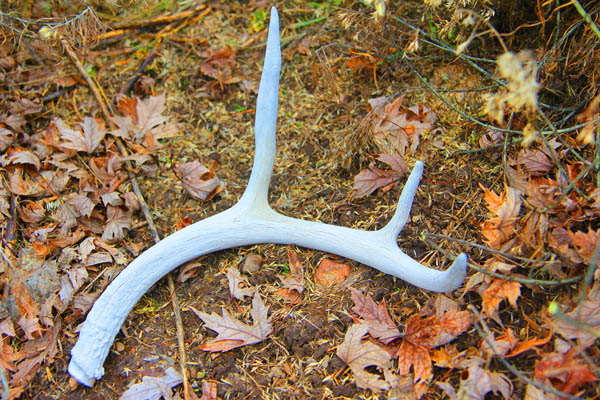
I often see a dozen or more trucks parked near mule deer winter range during prime shed hunting season. The antler seekers often carry high-end binoculars or even spotting scopes to give themselves an edge.
And sometimes they take things farther. Outdoor writer Marilyn Stone tells the story of two shed hunters who follow a trophy deer, waiting for its antlers to drop. When the antler falls, the two race each other to the spot. She writes:
The winner, wearing sneakers, not boots, told the game warden that he had been doing wind sprints to insure victory in a race he’d lost last year.
At a certain point, this starts feel more like a job than a hobby. Scoring sheets? Wind sprints?
Count me out. But if it’s your idea of fun, go for it.
However, at a certain point this moves beyond a bizarre obsession to a genuine threat to wildlife, in particular in the case of mule deer.
Adding Stress to Stressed Mule Deer
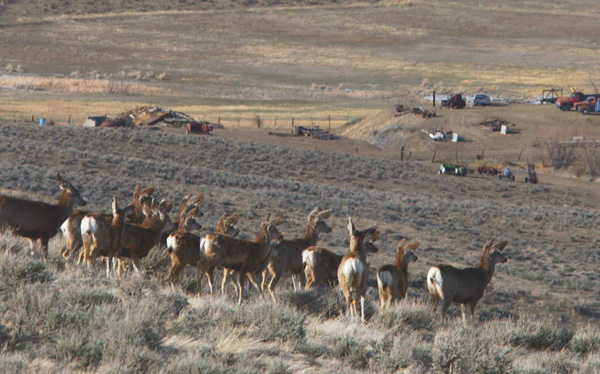
In much of the Rocky Mountain West, mule deer migrate long distances to avoid winter snow. They gather in lower-elevation areas each year, what biologists call winter range.
Large numbers of deer (and elk) gather at winter range. This means that shed hunters can find lots of antlers in one place.
It also means they could threaten mule deer.
As has been covered on this blog and others, mule deer are facing tough times. Their migration routes are interrupted by housing and energy development. Their winter range – once full of nutritious shrubs – has been replaced by invasive grasses.
Every calorie burned can put them at risk of starvation. Even causing a deer to stand could lead to death. They’re most vulnerable in the spring, when their energy stores are at their lowest.
Imagine the stress caused by a horde of antler seekers descending upon winter range before the deer have migrated back to the mountains. It could imperil herds of deer.
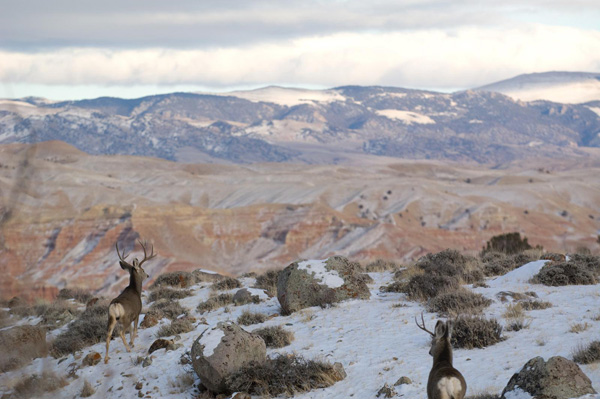
Some states have passed regulations prohibiting shed hunting while deer are still on their winter range.
Utah requires shed hunters to take an online course so they know how to gather sheds responsibly. Shed hunters must carry a certificate proving they’ve taken the course.
Those that harass mule deer can be charged with wildlife violations.
These are sensible regulations, designed to protect the mule deer we value.
And you can still look for antlers: just wait until April or May, when the deer are back in the mountains, far from their winter range.
The antlers I have found are prized possessions, tokens of a life spent outdoors. Each is unique, and each holds a memory of a specific outing.
I also love them because I love deer. I would never want my activities to put whole deer populations at risk.
I get the appeal of a springtime antler search. Just do it in a way that respects wildlife.
Mule deer don’t need any more stresses.
And, frankly, you don’t need the antlers that badly.
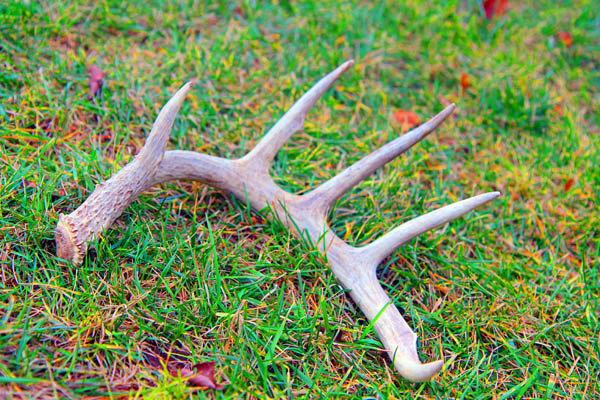



Thanks for the article, although it adds to my despair. Why do so many humans have to obsessively collect or monetize things to the point of being harmful to nature? This makes me want to go hunt antlers (off season, of course) and break them up. For smaller mammal food sources, etc. Except hiking with a sledge hammer would probably be too much for me. If only I were younger. 🙂
Hi, I hear you about the antlers. They are as cool as cool gets. Having been an avid shed hunter to now not picking up any. Once one realizes the amount of damage being done by doing this it wasen’t hard for me to stop doing it. If disturbing wildlife on the scale that it is now done isn’t enough to convince you this is wrong then the even bigger picture should.
The minerals and nutrients that are in an antler are nature’s way of putting that energy back into the ecosystem every year through the shedding of antlers. This is literally tons upon tons of enriching minerals and nutrients laid down upon the landscape everywhere. The process takes decades upon decades to happen. In some cases centuries to fully unleash the full potential of minerals and nutrients back into the enviorment. The scale that shed hunting has morphed into is troubling at the very least and mind-boggling to those that really consider the ramifications of doing this.
Its been three years since I gave up this past-time. Most places had been picked so clean by then that even finding an old antler was getting next to impossible. People now are out from the instant a deer or elk might shed to late into the spring. The disruption is enormous. What was once pretty cool at finding an antler especially a large one and never seeing another person, has mutated into a hulk. Resembling more of a commercial operation than an enjoyable pasttime.
It is time to stop this madness of what shed hunting has turned into and as unfortnate as it may sound, make it illegal. Anyone who is honest about this has seen how disruptive it can be to. And now with the advent of using dogs to find the antlers you have this on top of the other for wildlife to contend with.
Once things get over the top and out of control it is time to rein them in and stop the madness that shed hunting has turned into.
Against the law in Colorado before April 30, west of I-25. https://cpw.state.co.us/antlershed Montana is raffling rifles to those who take the pledge not to shed hunt. Wildlife is taking a beating from the outdoor rec industry.
If you dont need them or use the antlers for some qualified ” good” use, just LEAVE THEM ONTHE GROUND FGS!BEAR,
fox,wolves,mice,etc EAT THEM! THE ANTLERS ARE FOOD FOR THEM.
This is really great info! Let us know if we can share this on http://antlerchandeliers.uk as our readers would be very interested to read it 🙂 Hope all is well! Jon
Thank you Jon! You are welcome to share the post as long as you give credit to Matt Miller and link back to the original post on Cool Green Science.
Dear Matt,
It was interesting to read your blog. I actually was browsing not because of my own interest in Antlers, more like to figure out how to estimate their price. My father got Antlers, fully grown and I think it is from an Elk. He got them many years ago in Germany from a Man who owed him money and couldn’t repay it. So he gave my father these quite big Antlers, telling him they would be worth a lot of money.
Dad kept them in his restaurant on the wall, even when we moved to Spain he took them. Once a guest told my dad if he knew what he got as these Antlers were very expensive as it has the fully grown structure. I would appreciate if someone could estimate them for me, and tell me more about it, as it’s time to let them go. The man who gave the Antlers to my father and the guest both were talking about thousands of euros.
Thank you for your time
Rosa